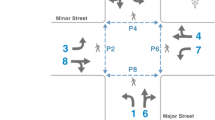Abstract
The Weber problem consists of finding a facility which minimizes the sum of weighted distances from itself to a finite set of given demand points.
In this paper we extend the Weber problem in the following way: We allow traveling along given linear curves (lines, line-segments, and rays) with high speed. Leaving and entering such a curve is allowed at all its points, and hence a network structure is continuously integrated in the plane. This extension gives the chance to model real-world situations like highway networks or other traffic infrastructure.
The extension of the Weber problem leads to a nonconvex problem. This paper presents a geometric approach to solve the extended Weber problem and gives discretization results for polyhedral gauges.
Similar content being viewed by others
References
Abellanas M, Hurtado F, Icking C, Klein R, Langetepe E, Ma L, Palop B, Sacristan V (2001) Proximity problems for time metrics induced by the L 1 metric and isothetic networks
Ahn H-K, Alt H, Asano T, Bae SW, Brass P, Cheong O, Knauer C, Na H-S, Shin C-S, Wolff A (2007) Constructing optimal highways. In: CATS’07: Proceedings of the thirteenth Australasian symposium on theory of computing, Darlinghurst, Australia. Australian Computer Society, Inc, Adelaide, pp 7–14
Aichholzer O, Aurenhammer F, Palop B (2004) Quickest paths, straight skeletons, and the city Voronoi diagram. Discrete Comput Geom 31(1):17–35
Cardinal J, Labbé M, Langerman S, Palop B (2005) Pricing of geometric transportation networks. In: CCCG, pp 92–96
Cardinal J, Collette S, Hurtado F, Langerman S, Palop B (2007) Moving walkways, escalators, and elevators. ArXiv e-prints, 705
Carrizosa E, Rodriguez-Chia AM (1997) Weber problems with alternative transportation systems. Eur J Oper Res 97:87–93
Chvátal C (1983) Linear programming. Freeman, New York
Current J, Daskin M, Schilling D (2002) Discrete network location models. In: Drezner Z, Hamacher HW (eds) Facility location. Applications and theory. Springer, New York, pp 81–118
Daskin M (1995) Network and discrete location. Wiley, New York
Dearing PM, Hamacher HW, Klamroth K (2002) Dominating sets for rectilinear center location problems with polyhedral barriers. Nav Res Logist 49:647–665
Drezner Z, Klamroth K, Schöbel A, Wesolowsky GO (2002) The Weber problem. In: Drezner Z, Hamacher HW (eds) Facility location. Applications and theory. Springer, New York, pp 1–36
Durier R, Michelot C (1985) Geometrical properties of the Fermat–Weber problem. Eur J Oper Res 20(3):332–343
Göerke R, Wolff A (2005) Constructing the city Voronoi diagram faster. In: Proceedings of the 21st European workshop on computational geometry (EWCG’05), pp 155–158
Gugat M, Pfeiffer B (2007) Weber problems with mixed distances and regional demand. Math Methods Oper Res 66(3):419–449
Hamacher HW, Klamroth K (2000) Planar location problems with barriers and block norms. Ann Oper Res 96(1–4):191–208
Körner M (2007) Das Weber Problem mit Block Metriken und Verkehrswegen. Master’s thesis, Georg-August Universität Göttingen (in German)
Minkowski H (1967) Gesammelte Abhandlungen, Band 2. Chelsea Publishing Company, New York
Nickel S (1995) Discretization of planar location problems. Shaker, Aachen
Ostrovsky-Berman Y (2005) Computing transportation Voronoi diagrams in optimal time. In: Proceedings of the 21st European workshop on computational geometry (EWCG’05)
Pfeiffer B, Klamroth K (2005) Bilinear programming formulations for Weber problems with continous and network distances. J Oper Res Soc Jpn 48(2):123–134
Pfeiffer B, Klamroth K (2008) A unified model for Weber problems with continuous and network distances. Comput Oper Res 35(2):312–326
Plastria F (1995) Continuous location problems. In: Drezner Z (ed) Facility location: a survey of applications and methods. Springer, New York, pp 225–262, Chap 11
Author information
Authors and Affiliations
Corresponding author
Rights and permissions
About this article
Cite this article
Körner, MC., Schöbel, A. Weber problems with high-speed lines. TOP 18, 223–241 (2010). https://doi.org/10.1007/s11750-009-0100-9
Received:
Accepted:
Published:
Issue Date:
DOI: https://doi.org/10.1007/s11750-009-0100-9




